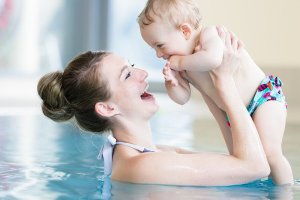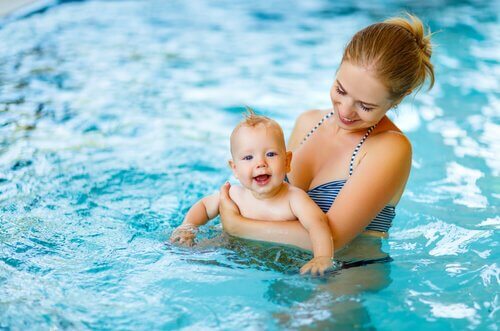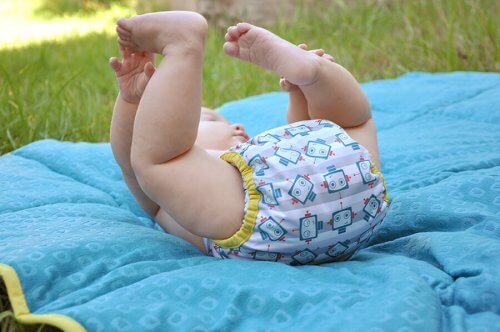Swim Diapers: A Guide for Parents

Swim diapers for babies are very useful, especially when going to the pool or beach with your family. In this day and age, there are plenty of options on the market to meet the needs and preferences of any family.
The initiative to use swim diapers was born out of the need for a more practical option when taking babies in the water. Today, we’ll take a close look at the characteristics and options when it comes to this type of diaper.
Types of swim diapers for babies
There are different types of swim diapers available on the market. To choose the right model for your baby, you should first be aware of the two main types: disposable diapers and reusable diapers. Both have their pros and cons, and both are very practical when it comes to taking your little one to the pool.
Disposable swim diapers
Some would say that disposable swim diapers are the best option. While these diapers don’t hold in water or urine, they do keep in a baby’s feces. Once a baby is done with the diaper, parents can easily throw it away.
Characteristics of disposable diapers in general
Without a doubt, this is the most common and popular type of diaper around the world. Still, it’s important to look at the main characteristics as well as their pros and cons.
Among the most important advantages is the fact that they are – as their name states – disposable. In other words, once you’re done with them, you just throw them away.

Below is a list of the main disadvantages when it comes to disposable swim diapers:
- When the diaper becomes wet, it swells up quite a bit. Therefore, parents must change the diaper right away after exiting the water.
- Absorbance is low – less than regular disposable diapers. The same is true for reusable swim diapers.
- Disposable diapers aren’t adjustable. This means liquids may leak out.
- The materials used to make disposable swim diapers is similar to that of regular disposable diapers. These materials may cause chafing or irritation on your baby’s skin.
- Disposable swim diapers come in different sizes, meaning that you’ll have to change sizes as your baby grows.
“Some would say that disposable swim diapers are the best option. While these diapers don’t hold in water or urine, they do keep in a baby’s feces.”
Reusable swim diapers
Another option for babies to use in the water are reusable diapers, also known as cloth swim diapers. The advantages to this option are numerous in comparison to disposables.
Besides being economical, you can use them over and over again without having to throw them away.
The characteristics and advantages of reusable diapers
Cloth diapers, or reusable diapers, are an excellent option for taking your little one to the pool, beach or splash park. The characteristics that make them stand out against disposable diapers are the following:
- One of the main characteristics is that this type of diaper doesn’t swell up when wet. Therefore, they offer children more comfort.
- Cloth swim diapers dry rapidly, thanks to their absorbance capacity.
- Leaks are unlikely, thanks to their waterproof lining that fits babies snugly.
- The fabric is breathable and the elastic is gentle on your baby’s legs.
- You don’t need to change the diaper if your baby goes pee. In fact, if you want, you can add an additional absorbent insert.
- Reusable swim diapers are adjustable. In other words, they adjust to the bodies of babies as they grow.

One of the advantages of reusable diapers is the possibility they offer as far as savings and the environment. They’re much more economical, because once they’re used, you can wash them and use them over and over again.
With this type of diaper, you avoid the elimination of large quantities of non-biodegradable substances. They’re an excellent way to care for the environment – and for your wallet as well.
In conclusion, there is a wide variety of swim diapers available for you to choose from. It’s important to consider the advantages and disadvantages of each, as well as your own family’s needs and preferences. Remember that your choice will reflect on your baby and your environment.
Once you decide, then there’s nothing more to worry about. Now it’s time to head to the pool and enjoy some fun with your little one.
Swim diapers for babies are very useful, especially when going to the pool or beach with your family. In this day and age, there are plenty of options on the market to meet the needs and preferences of any family.
The initiative to use swim diapers was born out of the need for a more practical option when taking babies in the water. Today, we’ll take a close look at the characteristics and options when it comes to this type of diaper.
Types of swim diapers for babies
There are different types of swim diapers available on the market. To choose the right model for your baby, you should first be aware of the two main types: disposable diapers and reusable diapers. Both have their pros and cons, and both are very practical when it comes to taking your little one to the pool.
Disposable swim diapers
Some would say that disposable swim diapers are the best option. While these diapers don’t hold in water or urine, they do keep in a baby’s feces. Once a baby is done with the diaper, parents can easily throw it away.
Characteristics of disposable diapers in general
Without a doubt, this is the most common and popular type of diaper around the world. Still, it’s important to look at the main characteristics as well as their pros and cons.
Among the most important advantages is the fact that they are – as their name states – disposable. In other words, once you’re done with them, you just throw them away.

Below is a list of the main disadvantages when it comes to disposable swim diapers:
- When the diaper becomes wet, it swells up quite a bit. Therefore, parents must change the diaper right away after exiting the water.
- Absorbance is low – less than regular disposable diapers. The same is true for reusable swim diapers.
- Disposable diapers aren’t adjustable. This means liquids may leak out.
- The materials used to make disposable swim diapers is similar to that of regular disposable diapers. These materials may cause chafing or irritation on your baby’s skin.
- Disposable swim diapers come in different sizes, meaning that you’ll have to change sizes as your baby grows.
“Some would say that disposable swim diapers are the best option. While these diapers don’t hold in water or urine, they do keep in a baby’s feces.”
Reusable swim diapers
Another option for babies to use in the water are reusable diapers, also known as cloth swim diapers. The advantages to this option are numerous in comparison to disposables.
Besides being economical, you can use them over and over again without having to throw them away.
The characteristics and advantages of reusable diapers
Cloth diapers, or reusable diapers, are an excellent option for taking your little one to the pool, beach or splash park. The characteristics that make them stand out against disposable diapers are the following:
- One of the main characteristics is that this type of diaper doesn’t swell up when wet. Therefore, they offer children more comfort.
- Cloth swim diapers dry rapidly, thanks to their absorbance capacity.
- Leaks are unlikely, thanks to their waterproof lining that fits babies snugly.
- The fabric is breathable and the elastic is gentle on your baby’s legs.
- You don’t need to change the diaper if your baby goes pee. In fact, if you want, you can add an additional absorbent insert.
- Reusable swim diapers are adjustable. In other words, they adjust to the bodies of babies as they grow.

One of the advantages of reusable diapers is the possibility they offer as far as savings and the environment. They’re much more economical, because once they’re used, you can wash them and use them over and over again.
With this type of diaper, you avoid the elimination of large quantities of non-biodegradable substances. They’re an excellent way to care for the environment – and for your wallet as well.
In conclusion, there is a wide variety of swim diapers available for you to choose from. It’s important to consider the advantages and disadvantages of each, as well as your own family’s needs and preferences. Remember that your choice will reflect on your baby and your environment.
Once you decide, then there’s nothing more to worry about. Now it’s time to head to the pool and enjoy some fun with your little one.
This text is provided for informational purposes only and does not replace consultation with a professional. If in doubt, consult your specialist.








